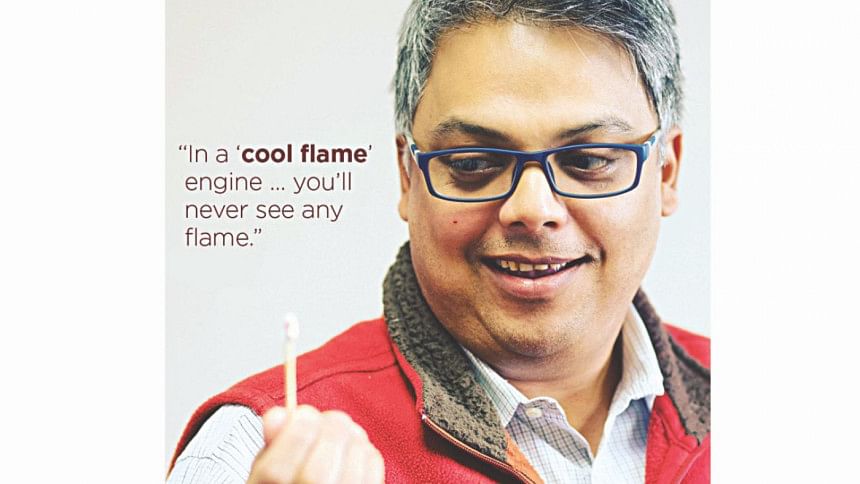Bangladeshi engineer-led team develops “cool burn” combustion tech

Tanvir Farouk graduated from BUET in 2001 and worked as a lecturer for less than a year in the Department of Mechanical Engineering before going for his master's at the University of Toronto in 2002. He completed his Ph.D. from Drexel University in 2009 and joined Princeton University's Combustion and Fuels. After Princeton, he joined the University of South Carolina as an Assistant Professor in 2012. His research work is focused on high-efficiency combustion, emission control, non-thermal plasma-based energy systems and reacting flow in general, with the work funded by the Department of Energy, Department of Defense, NASA and National Science Foundation, as well key industry.
How does the engine work?
I would like to clarify that we have not developed an engine but a combustion methodology/concept. Our experiments have shown that "Cool Flame" combustion can be attained for diesel-like fuels. In the "Cool Flame" burning mode the temperature is typically in the 700 – 800 K range and no visible flame is observed, rather the fuel-oxidizer mixture undergoes a homogeneous burn. The dynamics of the flame evolution and vaporization of the liquid spray allows a self-sustaining "Cool Flame" burn to be attained. We accidentally stumbled upon this unique phenomena while we were conducting "fire extinguishment" experiments onboard the International Space Station with the objective of developing fire safety protocol for human space flights.
What type of engine can utilize a "cool burn"?
Any type of compression ignition engines can be utilized for this purpose. The engine requires having the capability to conduct in-cylinder fuel blending with two different fuels of different reactivity and multiple injections to control in-cylinder fuel reactivity to optimize combustion phasing, duration and magnitude. All modern engines typically are now controlled by onboard chips – essentially making it computer controlled. For example, the valve timing of the engines is changed by the controlling unit depending on the type of fuel being used e.g. petrol versus octane. With such a significant development in the onboard control; controlling the reactivity by multiple injections of different types of fuel is readily achievable.
What are the advantages of cool burn of diesel?
Counter to the classical "hot flame", in a "cool flame" burn the temperature is low which results in a lower heat loss. No visible flame front is observed and fuel-oxidizer mixture combusts uniformly in a larger volume providing higher efficiency. NOx, which aresome of the major emissions in diesel engines, are greatly reduced in cool burn due to the lower combustion temperature.
What are the emissions like?
Low NOx, low particulate matter (PM) and unburnt hydrocarbon (UHC) and carbon-monoxide through exhaust gas recirculation and after treatment. Having an exhaust gas recirculation in place i.e. having the exhaust gas recirculated back to the engine and mixed with the new fuel charge the unburnt hydrocarbon and carbon-monoxide can undergo a complete burn.
How efficient is a such an engine compared to tradition diesel engines?
In comparison to a gasoline engine which has an efficiency of 35% a conventional diesel engine has an efficiency of 45%. An engine employing "cool burn" enables it to achieve about 65% efficiency.
What challenges are ahead?
Integration to all classes of engines is always a challenge. At the same time industries and companies are sometimes not fully receptive to overhaul a technological concept that they are familiar with and have been manufacturing and selling. The second challenge is due to fuel variability. Every day the fuel we buy from the fuel station is slightly different from the previous day – the variability of the source which could be due to geographical location or the variability between different oil wells.
When do you think this technology would be ready for commercial use?
We are currently working with one of our collaborators to conduct and analyze a series of engines tests. I cannot provide a definite timeline for commercial use at the moment.
Why do you think cool burn of diesel is relevant in a world moving towards EVs and fuel cells?
Even though the world is moving towards EV's and fuel cells vehicles they scale up perfectly for small, personal vehicles. Long distance freight hauling still depends on diesel (ground transport) or even heavier fuels (marine vessels). As a consequence, the cool burn of diesel will contribute to these sectors by not only providing higher efficiency but also lower emissions. At the same time, stationary engines that contribute to power generation will also be benefitted from this sector. It is sometimes a misconception that EV and fuel cell driven vehicles remove our dependence on fossil fuels. However, to charge the electric car battery it has to be plugged into a socket. The power to the socket could be coming from a natural gas power plant, diesel generator or even a gas turbine.

 For all latest news, follow The Daily Star's Google News channel.
For all latest news, follow The Daily Star's Google News channel. 



Comments